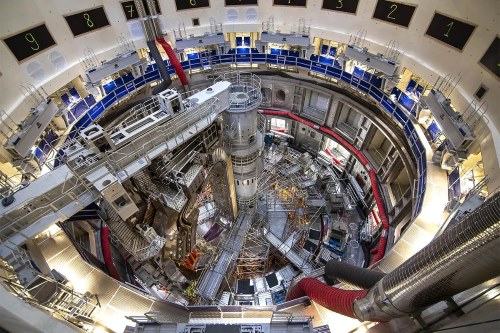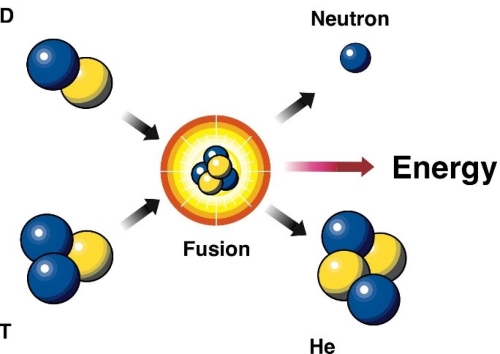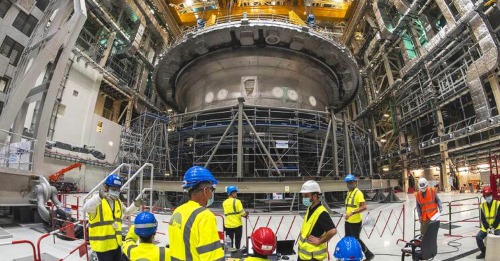During a three-day visit to France, PM Modi visited the International Thermonuclear Experimental Reactor (ITER) in Southern France. ITER, the world’s largest science experiment, aims to master nuclear fusion by creating a ‘Mini Sun’. India has played a crucial role in this project by contributing 10 percent of the costs and building the Cryostat that houses the Nuclear Reactor.
The ITER project, which originated in the mid-1980s, was initially a collaborative effort involving seven partners: the US, Russia, South Korea, Japan, China, India, and the European Union (EU). The project's estimated cost is over 22 billion Euros.
What is ITER’s Vision behind the ‘Mini Sun’ project?

Source: sciencefocus
The International Thermonuclear Experimental Reactor (ITER), also known as "The Way," aims to provide the world with an unlimited supply of clean energy.
ITER, the world's largest Tokamak device, will be the first fusion device to produce more heat than it uses to initiate the fusion reaction. It will rely on cutting-edge technologies, essential for future fusion power, to test magnetic confinement for fusion energy production. ITER's millions of components and advanced systems will be used to measure performance and inform the development of future commercial fusion power plants.
ITER is a collaborative effort involving 35 nations, including India, the United States, the European Union, China, Russia, and South Korea. Initiated in 2006, the project seeks to demonstrate the feasibility of nuclear fusion as a viable energy source on Earth. Unlike nuclear fission, which powers today’s nuclear plants and generates radioactive waste, fusion produces no long-lived waste and emits zero greenhouse gases.
What is Nuclear fusion?

Source: energy.gov
Nuclear Fusion is a process in which two light atomic nuclei combine to form a single heavier nucleus, accompanied by the release of a substantial amount of energy.
Plasma, often referred to as the fourth state of matter, is composed of charged particles and free electrons. Unlike solids, liquids, and gases, it exhibits unique properties under extreme conditions, making it the ideal environment for fusion reactions.
Stars, like our Sun, harness nuclear fusion to generate energy. Within the Sun's core, the temperature soars to roughly ten million degrees Celsius. This intense heat allows atomic nuclei to overcome their natural repulsion and collide with enough force for the strong nuclear force to bind them together, initiating fusion.
Sustaining fusion requires confining the reacting nuclei within a specific area to optimize collisions. The Sun's immense gravitational force provides the necessary pressure to maintain continuous fusion reactions.
How does Nuclear Fusion work in Creating a ‘Mini Sun’?
Fusion occurs when two hydrogen atoms combine under extreme pressure and temperature, forming a helium atom and releasing a massive amount of energy. The processes involved are the same as the sun and other stars getting powers. Scientists at ITER are working to replicate this process inside a tokamak, a doughnut-shaped reactor that uses powerful magnetic fields to confine plasma—a superheated gas where fusion occurs. Unlike nuclear fission (used in current reactors), fusion also produces zero greenhouse gas emissions. It Does not generate long-term radioactive waste and also Offers an inexhaustible source of energy.
How did ITER Tokamak help in creating ‘ Mini Sun’?

Source: BBC sciencefocus
The world's largest Tokamak device which is found in ITER uses a doughnut-shaped reactor using magnetic fields to confine plasma at extreme temperatures. It is expected to reach temperatures 10 times hotter than the Sun's core (150 million°C). Here is given its aspects in detail:
| Aspect | Details |
| Weight | 23,000 tonnes (equal to 3 Eiffel Towers) |
| Components | Over 1 million parts |
| Buildings | 39 structures spanning an area similar to Wembley Stadium |
| Estimated Cost | $22 billion (may rise to $65 billion) |
| Completion Date | Projected by 2039 |
Now, we will study about Size complexities of this project and its challenges & reasons for the delay.
Size and Complexity
The ITER project spans 39 massive buildings, covering an area comparable to Wembley Stadium in England. The tokamak itself weighs an astonishing 23,000 tonnes—equivalent to three Eiffel Towers—and comprises over 10 million individual parts.
Challenges and Delays
Despite its groundbreaking potential, ITER has faced significant delays due to the complexity of assembling first-of-a-kind components. Originally set for completion by 2020, the project was fully assembled only in 2024. Scientists now predict that the first plasma experiments will begin by 2039.
Also Read| Why Is ISRO’s CE20 Cryogenic Engine Ignition Test Significant?
India’s Role in ITER
India has played a vital role in the ITER project by contributing both financially and technologically. Below is a structured breakdown of its involvement:

Source: reuters
Financial Contributions
India joined ITER as a full partner in 2005, committing to fund 10% of the project’s total cost. Initially estimated at $5 billion, the project’s expenses have surged to approximately $22 billion, with some estimates suggesting a final cost of $65 billion. Despite these rising costs, India remains steadfast in its commitment, contributing both financially and technologically to ensure ITER’s success.
Engineering and Technological Contributions
India has played a crucial role in developing some of ITER’s most vital components:
- Cryostat – The Largest Component of ITER: Designed and built by Larsen & Toubro in Gujarat, the cryostat is the world’s largest high-vacuum, ultra-cool chamber. It surrounds the tokamak’s superconducting magnets and maintains temperatures as low as -193 degrees Celsius. Comprising 54 individual units, the cryostat was transported to France in four sections and assembled on-site in 2020.

Source: projectsmonitor
- Cryolines and Cooling Systems: India has developed cryogenic pipelines (cryolines) that transport liquid nitrogen and helium to keep the reactor’s components at optimal temperatures. These systems are essential for ensuring the stability and efficiency of fusion reactions within the tokamak.
- Plasma Heating and Power Supply Systems: Indian engineers have contributed to the development of external heating systems that help maintain the plasma inside the reactor at over 150 million degrees Celsius—ten times hotter than the Sun’s core. The country has also supplied power supply components that help sustain the magnetic fields crucial for plasma confinement.
- Vacuum Vessel Shields and Diagnostic Subsystems: India has provided in-wall shields for the vacuum vessel, a critical component of the reactor that contains the fusion reaction. Advanced diagnostic subsystems developed in India help monitor and control plasma behavior inside the tokamak.

Source: BBC sciencefocus
India’s Growing Focus on Nuclear Energy
India’s involvement in ITER aligns with its broader strategy to expand nuclear power as a clean energy source. The country aims to increase its nuclear energy capacity from the current 8,180 MW to 22,480 MW by 2031-32 and eventually reach 100 GW by 2047.
Policy Initiatives
The government plans to amend the Civil Liability for Nuclear Damages Act and the Atomic Energy Act to facilitate more investment in nuclear energy. The Nuclear Energy Mission, announced in the 2024 Budget, allocates Rs 20,000 crore for research and development of Small Modular Reactors (SMRs), intending to deploy five indigenous SMRs by 2033.
Conclusion
India’s contributions to ITER highlight its growing leadership in advanced scientific research and clean energy initiatives. As the world moves towards sustainable energy solutions, India’s role in developing nuclear fusion technology positions it at the forefront of global efforts to combat climate change and transition to a carbon-free future. By investing in nuclear fusion and expanding its domestic nuclear energy capabilities, India is not only securing its energy future but also playing a pivotal role in shaping the world’s sustainable energy landscape.
Also Read| How old is the Chandrayaan-3 Landing Site on the Moon?
Comments
All Comments (0)
Join the conversation